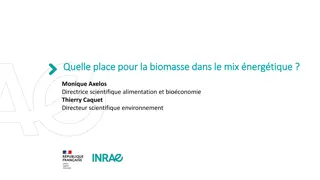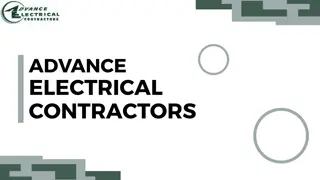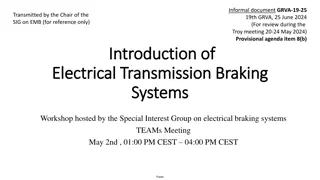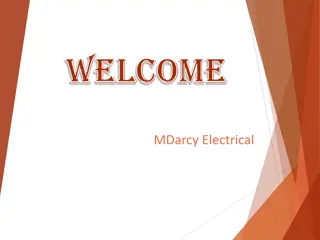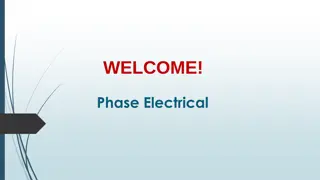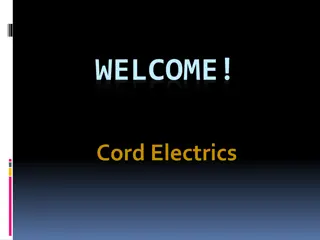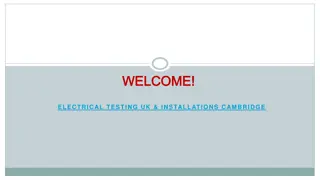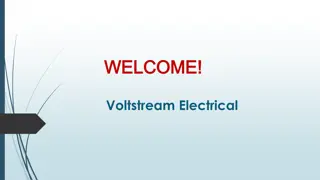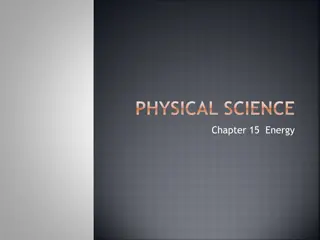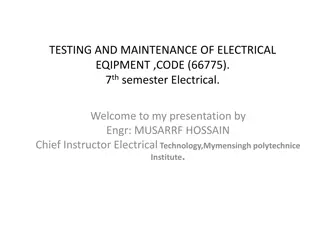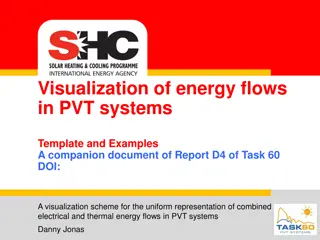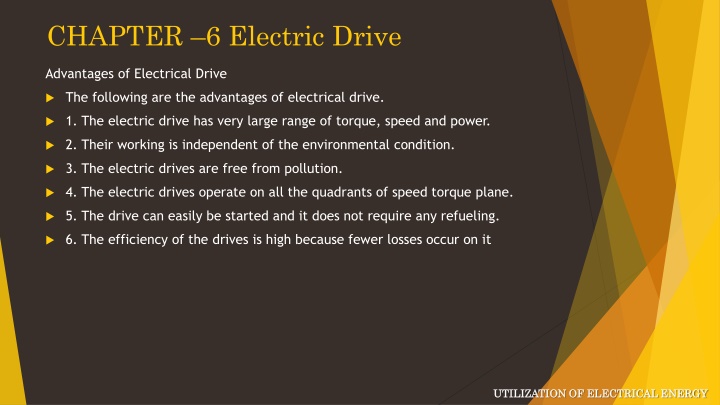
Advantages and Applications of Electrical Drive Systems
Discover the various advantages of electrical drives, such as wide torque, speed, and power ranges, independence from environmental conditions, pollution-free operation, and high efficiency. Learn about different types of mechanical loads and motors used in electric drives, as well as methods of power transfer like belt technology with their benefits. Explore the advantages of belt drives, including cost-effectiveness, simplicity, low maintenance, and more.
Download Presentation

Please find below an Image/Link to download the presentation.
The content on the website is provided AS IS for your information and personal use only. It may not be sold, licensed, or shared on other websites without obtaining consent from the author. If you encounter any issues during the download, it is possible that the publisher has removed the file from their server.
You are allowed to download the files provided on this website for personal or commercial use, subject to the condition that they are used lawfully. All files are the property of their respective owners.
The content on the website is provided AS IS for your information and personal use only. It may not be sold, licensed, or shared on other websites without obtaining consent from the author.
E N D
Presentation Transcript
CHAPTER 6 Electric Drive Advantages of Electrical Drive The following are the advantages of electrical drive. 1. The electric drive has very large range of torque, speed and power. 2. Their working is independent of the environmental condition. 3. The electric drives are free from pollution. 4. The electric drives operate on all the quadrants of speed torque plane. 5. The drive can easily be started and it does not require any refueling. 6. The efficiency of the drives is high because fewer losses occur on it UTILIZATION OF ELECTRICAL ENERGY UTILIZATION OF ELECTRICAL ENERGY
CHARACTERISTICS OF DIFFERENT TYPES OF MECHANICAL LOADS 1. Lifting load: Such loads require constant torque at all the speeds. The speed torque is shown in figure below. as in fig. (a) UTILIZATION OF ELECTRICAL ENERGY UTILIZATION OF ELECTRICAL ENERGY
2. Air and fluid friction load: Such types of loads require changes in torque. The torque varies as square of load i.e. e.g. blowers fans and pumps as in fig. (b). 3. Loads due to friction: Such types of loads are due to friction. Whenever two surfaces move over one another as in fig. (c). 4. Deformation loads: Such types of loads require torque which may decrease with the increase in speed. E.g.- lathes, boring machines, and cutting machines etc. UTILIZATION OF ELECTRICAL ENERGY UTILIZATION OF ELECTRICAL ENERGY
TYPES OF MOTORS USED IN ELECTRIC DRIVE UTILIZATION OF ELECTRICAL ENERGY UTILIZATION OF ELECTRICAL ENERGY
METHODS OF POWER TRANSFER BY DIRECT COUPLING BELT TECHNOLOGY One of the most common devices, belt drives are used to transmit motion from one shaft to another with the help of a thin inextensible band that runs over two pulleys. It is basically a looped strip of flexible material that mechanically link the rotating shafts. UTILIZATION OF ELECTRICAL ENERGY UTILIZATION OF ELECTRICAL ENERGY
THE ADVANTAGES OF A BELT DRIVE: 1. Belt drives are cost-effective. New belt drive efficiency can be up to 95-98 %. 2. They are simple to use 3 Belt drives do not require parallel shaft 4 They have a low maintenance cost 5 They come with overload and jam protection 6 Different speeds can be obtained by means of step or tapered pulleys 7 When the distance between shafts is very large, belt drives are the most economical options 8 Damp out noise and vibration 9 Load fluctuations are shock-absorbed, increasing the machinery life UTILIZATION OF ELECTRICAL ENERGY UTILIZATION OF ELECTRICAL ENERGY
Disadvantages 1 Belt drives are not compact. 2 Compared to other mode power transmission, they have a short life service. 3 Angular velocity of belt drives isn t constant. This leads to stretching, slipping, and wearing of belt. 4 Belt drives usually inflict a heavy load on shafts and bearings. 5 For wearing and stretching compensation, they additionally need an idler pulley or some adjustment of center distance. 6 The velocity ratio varies because of belt slip. UTILIZATION OF ELECTRICAL ENERGY UTILIZATION OF ELECTRICAL ENERGY
Chain Technology As the name suggests, chain drives come with an endless series of chain links with a net of toothed sprockets. Unlike belt drives, there is no slip in chain technology. However, they are mostly suited for small center distances, usually up to 3 meter. UTILIZATION OF ELECTRICAL ENERGY UTILIZATION OF ELECTRICAL ENERGY
ADVANTAGES OF CHAIN DRIVES 1 Chain drives have low maintenance cost 2 More compact and are easy to install compared to belt drive 3 Highly efficient, chain drives gives the advantage of more power compared to belts 4 They can operate even in wet conditions 5 Positive drives with no slip or creep 6 It can be used for both small and large center distances 7 Unlike belt drives, angular velocity remains constant in chain drives 8 Chain drives do not deteriorate due to sunlight, oil, grease, or age 9 Lower load on shaft than belt drives UTILIZATION OF ELECTRICAL ENERGY UTILIZATION OF ELECTRICAL ENERGY
DISADVANTAGES OF CHAIN DRIVES 1 these are noisy and can also cause vibrations 2 high production cost 3 it needs regular lubrication 4 Driving and driven shafts must be perfectly aligned and parallel 5 They can have velocity fluctuations when unduly stretched 6 higher initial cost than belt 7 Not suitable for applications where it is necessary for the drive to slip 8 They have lower load capacity and service life compared to gear drives UTILIZATION OF ELECTRICAL ENERGY UTILIZATION OF ELECTRICAL ENERGY
GEAR TECHNOLOGY In the world of mechanical power transmission, gear drives have a very special and prominent place. This is the most preferred technology when you need to transmit considerable power over a short distance with a constant velocity ratio. The mechanism of gear drives is quite simple the teeth, which are cut on the blanks of the gear wheel, mesh with each other to transmit power. To avoid slipping, the projections on one disc mesh with the recesses on other disc in gear drives. This technology uses different types of gears for power transmission. In fact, it can transmit power not only between parallel shafts, but also between non-parallel, co-planar, and intersecting etc. shafts. UTILIZATION OF ELECTRICAL ENERGY UTILIZATION OF ELECTRICAL ENERGY
ADVANTAGES OF GEAR DRIVES: 1. They can transmit large power 2. They have high transmission efficiency 3. They are positive and non-slip drives 4. These are the most compact compared to belt and chain drives 5. Large and constant velocity ratio of 60:1 can be obtained by using gear trains with minimum space 6. Gear drives are mechanically strong, allowing scopes for lifting higher loads 7. They can transmit motion over small center distance of shafts 8. These drives are ideal for low, medium, high power transmission 9. Gears can transmit motion even between non-parallel intersecting shafts 10. Longer service life compared to both belt and chain drives UTILIZATION OF ELECTRICAL ENERGY UTILIZATION OF ELECTRICAL ENERGY
DISADVANTAGES OF GEAR DRIVES: 1. They have no flexibility 2. They are less economical compared to belt and chain drives 3. Gear drives cannot be used for shafts with large center distances 4. These drives require regular lubrication and a more complicated process of applying it 5. Noise and vibrations are increased at a high speed 6. Some part of the machine can get permanently damaged because of the toothed wheel of gears. This is more common in case of excessive loading 7. Using multiple gears increase the machine s overall weight 8. Not suitable for transmitting motion over a large distance 9. They are not ideal for large velocities UTILIZATION OF ELECTRICAL ENERGY UTILIZATION OF ELECTRICAL ENERGY
SELECTION OF MOTORS FOR DIFFERENT TYPES OF DOMESTIC LOADS Electric motor to be used as a drive are selected according to the types of characteristics of the Load lot of applications can be driven by more than one type of motor selection of a specific type of motor does not exclude other types to be used for the same application. 1. Electrical Characteristics 2. Mechanical Considerations UTILIZATION OF ELECTRICAL ENERGY UTILIZATION OF ELECTRICAL ENERGY
AC MOTORS Here, the current is alternating, and so the motor will run but only at sine-wave frequency. Given below are the two types of AC motors Induction motors. Induction motors are regularly used for constant-speed and adjustable-speed drive applications. These are popular for automated industrial applications including general- purpose and inverter duty. Synchronous AC motors. These are three-phase AC motors that run at synchronous speed without a slip. Unlike induction motors, these are not self-starting, and have to be run up to synchronous speed by some means before these can be synchronized to the supply. These motors are used when load keeps changing and speed is critical. These are mainly used in constant-speed applications. Single-phase AC motors. These are small-size motors used in domestic applications like fans, hair dryers, washing machines, vacuum cleaners, kitchen equipment, blowers, small power tools, dairy machinery, small farming equipment and so on. UTILIZATION OF ELECTRICAL ENERGY UTILIZATION OF ELECTRICAL ENERGY
1. Electrical Characteristics: (a) Operating or Running Characteristics of Electric Motors: While studying electrical behavior of a machine under normal operating conditions, the speed-torque characteristic, speed- current characteristic, losses, efficiency, magnetizing current and power factor at various loads are kept in view. The last two factors, i.e., magnetizing current and power factor are to be considered in case of ac motors only. Other features, such as temperature rise and insulation strength, are taken care of by Indian Standard Specifications, therefore if a motor is purchased built by a reputed manufacturer in accordance with the appropriate specifications, it will prove satisfactory in these respects. UTILIZATION OF ELECTRICAL ENERGY UTILIZATION OF ELECTRICAL ENERGY
(b) Starting Characteristics of Electric Motors: The study of starting characteristics of a motor is essential to know whether the starting torque that the motor is capable of developing is sufficient to start and accelerate the motor and its load to the rated speed in a reasonable time or not. This feature is very important particularly when the motor is to be selected for the services in which either it is to start against full-load torque (as for driving grinding mills or expellers) or it is to be stopped and started very frequently (as in case of lifts and hoists), i.e., where high starting torque is essential. The torque developed by the motor at the starting is required to overcome the initial static friction and accelerate the motor and load to the full speed. The torque required to overcome the initial static friction cannot be easily determined and in certain cases as for starting a machine, which has been out of use for some time, it may be much more than the full-load torque. The torque for accelerating depends upon the load torque. UTILIZATION OF ELECTRICAL ENERGY UTILIZATION OF ELECTRICAL ENERGY
(c) Speed Control: Speed control means intentional change of the drive speed to a value required for performing the specific work process. This concept of speed control or adjustment should not be taken to include the natural change in speed which occurs due to change in the load on the drive shaft. The desired change in speed is accomplished by acting accordingly on the drive motor or on the transmission connecting it to the unit it serves to drive. This may be done manually by the operator or by means of some automatic control device. UTILIZATION OF ELECTRICAL ENERGY UTILIZATION OF ELECTRICAL ENERGY
(d) Electric Braking: If the load is removed from an electric motor and supply to it be disconnected, it will continue to run for some time due to inertia. The time elapsing before it stops will be especially long if the motor is massive and has run at high speed. It is essential, however, in many cases that the motor and its driven machine be stopped quickly (in machine tools, cranes, hoists etc.). In fact, quick stopping of a motor is more essential than quick starting. Delay in starting up a motor only causes the machinery to stand idle; a delay in stopping a motor may result in heavy damage to equipment or to the manufactured products and even the loss of human life. UTILIZATION OF ELECTRICAL ENERGY UTILIZATION OF ELECTRICAL ENERGY
2. Mechanical Considerations: (a) Types of Enclosures: In order to protect machines against the ingress of dirt and dust or larger foreign bodies like spanners, vermin etc. into it, it is desirable that some suitable enclosure be provided. But the enclosure provided for this protection will interfere with the free entry of cool air into the machine with the result that an enclosed machine does not give the same output as does an open type machine of the same dimensions for a given temperature rise. (b) Types of Bearings: Bearings are those parts of a machine which house supports and restrain the rotating parts. The moving part of the bearing is known as journal and the stationary part that supports the moving part is known as bearing. The main functions of a bearing, besides supporting the rotating parts, are: (i) To permit free rotation of the moving components with minimum friction and (ii) To maintain the rotating member of the machine in a fixed physical location relative to the stationary member. UTILIZATION OF ELECTRICAL ENERGY UTILIZATION OF ELECTRICAL ENERGY
(c) Types of Transmission of Drive: Mechanical power available at the motor shaft has to be transmitted to the driven machine or machines. There are various methods of doing so. 1. Direct Drive: In this type of drive the driving member is connected direct to the driven member, without any interposed gearing, by means of solid or flexible coupling. It is the simplest method, space required is less than with belt drive and efficiency is 100 per cent 2. Belt Drives: These are the least expensive drives. These are employed where a speed change is desired in the transmission of power and where it is not absolutely essential to maintain a fixed speed ratio between the driving and driven shaft. 3. Rope Drive: Rope drive, the drive by means of ropes running over pulleys having a number of grooves, is used for power ranges beyond the limit of V-belt drive. It is a long center drive. Main advantages of rope drive are negligible slip and ability of taking sudden loads. 4. Chain Drive: Though chain drive is more costly than belt and rope drives but it is more efficient, can be used for high speed ratio (the limit being 7:1 with a distance between pulley center of about 1.5 to 2 times the diameter of the larger pulley) and has no slip. UTILIZATION OF ELECTRICAL ENERGY UTILIZATION OF ELECTRICAL ENERGY
5. Gear Drive: It is a short Centre positive drive. It is very important to have proper alignment in the absence of which, otherwise, we may have to pay in the form of bent motor shafts. It was the first form of power transmission in the early steam driven mills. 6. Vertical Drive: In this type of drive motor is arranged with its axis vertical. This arrangement frequently proves to be convenient. 7. Noise Level: A feature of importance in choosing a motor, as well as any other apparatus, is that of noise; extreme silence is, of course, essential in motors for domestic purposes, use in hospitals, theatres, another similar institutions. Even for ordinary industrial purposes it is essential to keep motor noise to a minimum because it causes fatigue to the workers and, therefore, affects the overall efficiency and output of the factory adversely. UTILIZATION OF ELECTRICAL ENERGY UTILIZATION OF ELECTRICAL ENERGY
Rating of Machines: A name plate fixed to the outside frame of an electrical machine records the data pertaining to its rating. A machine rating specifies the voltage, current, speed, excitation, power factor, efficiency, power output etc. The rating of a machine should give all information necessary so that, if the machine is operated within the limits of all factors specified in its rating, the machine will operate satisfactorily and safely and will give reasonable length of service. Therefore, the rating of a machine must give the necessary information to safeguard the application of the machine from conditions of operation which; (i) would result in unsafe mechanical or electrical strains upon any part of its structure or (ii) would result in excessive deterioration of the mechanical or electrical characteristics of the materials of which the machine is constructed. To give this information, the rating of an electric machine should include the output, voltage, speed, and any other information that may necessary for the proper operation of the machine. UTILIZATION OF ELECTRICAL ENERGY UTILIZATION OF ELECTRICAL ENERGY
COST OF MOTOR: Although the cost has been placed as last factor in the above list, but it is the major factor for the choice of motor. While considering the cost, the capital as well as running cost of a motor should be considered. In most of the cases, we find that equipment very cheap in first cost is costlier in running cost due to poor efficiency, low power factor and short life. UTILIZATION OF ELECTRICAL ENERGY UTILIZATION OF ELECTRICAL ENERGY
Selection of drive for applications such as general workshop, textile mill, paper mill, steel mill, printing press, crane and lift etc. with application of flywheel 1.DOMESTIC LOAD:- Small universal motors are used for domestic load such as refrigerator, vacuum cleaner, washing machine Fan etc. 2. General workshop:- For Grinding and Milling machines up to 50 HP Motor may be DC shunt motor or squirrel cage and slip ring induction motor. For Planner a dc compound motor may be used. For Punching or shearing machine dc shunt or compound motor or slip ring induction motor may be used along with a Flywheel. 3. Textile mill:- Totally enclosed and damp proof motor is used. Three phase ac motor should be used. 4. Paper mill:- DC compound motor coupled with flywheel and AC cage or slip ring induction motor may be used. 5. Steel rolling mill:- The dc shunt motor with flywheel or induction motor with speed control may be used. 6. Printing press:- For constant speed, synchronous motor is used. Constant speed is needed to keep uniform thickness of paper. Squirrel cage motor or dc motor may also be used. 7. Crane and Lift:- DC compound, slip ring induction motor, repulsion motor or ac commutator motor may be used. 8. Electric trains:- The dc or ac series motor may be used. 9. Mining Industry:- The totally flame proof DC compound or cage / slip ring induction motor may be used. 10. Floor mill:- Totally enclosed DC compound motor with Flywheel may be used. UTILIZATION OF ELECTRICAL ENERGY UTILIZATION OF ELECTRICAL ENERGY
Selection of motors for Domestic Appliances Small universal motors, usually series type is used in domestic appliances, such as split-phase induction motor single-phase AC motor is the commonly used in major appliances such as air conditioners and clothes dryers. These motors provide much greater starting torque. 1 vacuum cleaner: A universal motor is typically used as suction motor across vacuum cleaners. The universal motor is a series DC-motor that is specially designed to operate on alternating current (AC) as well as on direct current (DC). Universal motors have high starting torque, operate at high speed, and are lightweight.- 2 Sewing machines:- Industrial machines used to use either single-phase universal motors or 3-phase brushless motors 3 mixer:- The motor used in mixer grinder is generally a universal motor. The motor has stator and rotor. The stator is made of laminated steel. There are poles on the stator. 4 Washing machines:- Capacitor start induction motors. They have the same running performance as split-phase motors but a higher starting torque. They are mainly used in washing machine drive systems. UTILIZATION OF ELECTRICAL ENERGY UTILIZATION OF ELECTRICAL ENERGY
References: www.google.com https://www.azom.com/article.aspx?ArticleID=2629 https://www.sharrettsplating.com/blog/electroplating-non-conductive- materials/#electroless-plating https://onlineaavedan.com/study_material/1546513584.pdf https://www.yourelectricalguide.com/2017/03/resistance-heating.html https://www.theweldingmaster.com/atomic-hydrogen-welding/atomic-hydrogen- welding-2/ http://www.brainkart.com/article/Induction-heating--Types,-Advantages,- Application_13690/ Textbooks SlideShare Wikipedia Quora UEE, Ishan Publications 2017-2018. UTILIZATION OF ELECTRICAL ENERGY UTILIZATION OF ELECTRICAL ENERGY



